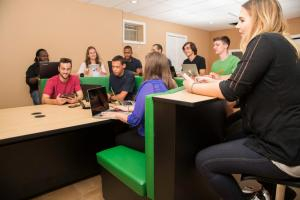 The first Tuesday of every month, the Huntington Chamber Of Commerce Education Committee meets to discuss relevant topics and challenges faced by today’s modern workforce. Then we decide which topics are most important to our local professionals and create hour long seminars. It is a great resource for the business community because these seminars are free, we provide breakfast, and the content is presented by experts in their particular field. The committee is made up professionals from a number of industries including financial planning/ wealth management, graphic design, business consulting, insurance, higher education administrators, architects, you get the picture. We are a diverse group.
The first Tuesday of every month, the Huntington Chamber Of Commerce Education Committee meets to discuss relevant topics and challenges faced by today’s modern workforce. Then we decide which topics are most important to our local professionals and create hour long seminars. It is a great resource for the business community because these seminars are free, we provide breakfast, and the content is presented by experts in their particular field. The committee is made up professionals from a number of industries including financial planning/ wealth management, graphic design, business consulting, insurance, higher education administrators, architects, you get the picture. We are a diverse group.
Today’s meeting was interesting because we had a guest speaker who happened to be the Assistant Superintendent of Instruction and Curriculum for my school district, a K-12 public system with about 6,000 students. He was talking about the nearly $2.9 million in technology grants the school district has received in the past four years. This has allowed them to continue to expand their wireless bandwidth and initiate and grow their STE(A)M programs. Kindergartners are learning drag and drop code, 3rd graders are using a 3D printer and 3D immersion for their robotics and other classes, 4th graders are learning to write code, 6th graders are beginning career readiness training, 6th and 7th graders are rolling out an ongoing 1:1 program with Chromebooks. I can go on.
As is inevitable with business discussions that include the word “technology,” many of the committee members started commenting to this Superintendent about the lack of workforce ready students coming out of high school and college “these days” because they have no soft skills. That is, they don’t know how to interact with “the rest of us,” their communication skills and attention to detail are deficient, pretty much what you would expect from the “us vs. millennials” mindset. And all of this is a result of the overuse of technology. But what I found most interesting is that the Superintendent and the committee members weren’t talking about the same technology.
The committee members were faulting video games, phones/ texting and social media for the absent manners. They heard the word “technology” and immediately thought of personal technology like phones, Facebook and Xbox (yes, social media lives in their definition of technology). The Superintendent, on the other hand, was talking about a different technology; giving examples of how his type of educational technology actually fosters workforce readiness through collaboration, problem solving and hands on work. The committee members looked at each other a bit confused and then one said- “Oh, you’re talking about AV. That’s different.”
Is it different? Of course, on a basic level it is all technology. But for people outside of the audiovisual worlds, technology has a different meaning (perhaps even a different connotation) than for those of us inside. Does our understanding of the facets of technology from software to hardware and signal distribution to bandwidth requirements allow us to form a different definition of technology than most others? Probably. Does this different perception of technology challenge clear communication during project scope discussions with potential clients? Yup, this likely happens. What this has reinforced is that we have to be as specific as possible when talking about technology with groups outside of our AV world. Classroom technologies are different than home technologies. Corporate video chat is different than Xbox video chat. Or is it????
PS- I will tackle the millennial “soft skills” issue another time…an issue or a generational misinterpretation?





